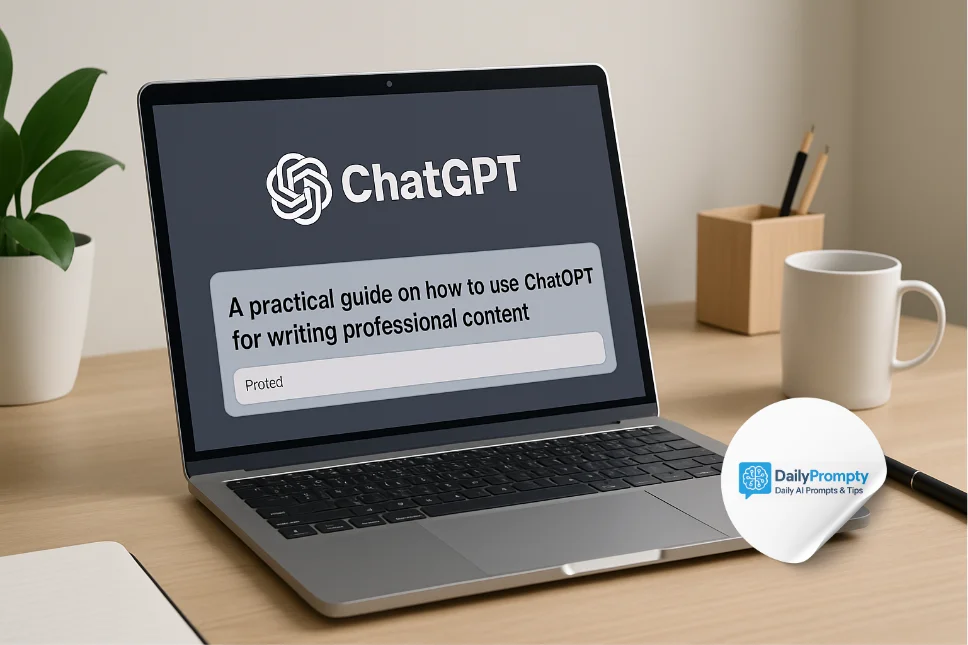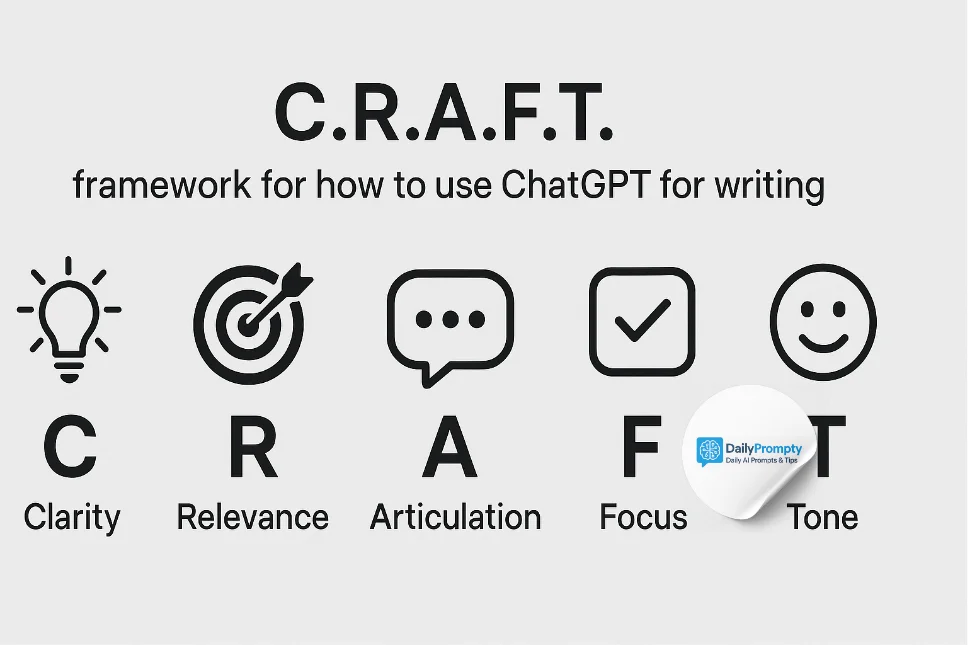You’ve heard the hype. You’ve seen the examples. However, when you attempt to use ChatGPT for writing, the results often feel… flat. The tone is robotic, the ideas are generic, and it just doesn’t sound like you.
Sound familiar? This is the most common frustration with AI writing tools. The problem isn’t the AI; it’s the instructions we give it.
This is where most guides often fall short. They give you a list of prompts but don’t teach you the system behind them. In this guide, we’ll show you exactly how to use ChatGPT for writing by introducing a simple yet powerful framework. Forget robotic text. It’s time to turn ChatGPT into your personal writing assistant that helps you create better, faster content that truly shines.

The #1 Mistake People Make with ChatGPT
Before we get to the solution, let’s identify the problem: giving vague, one-line commands.
If you type “Write a blog post about productivity,” you will get a generic, uninspired article. Why? Because you gave the AI no context, no personality, and no direction.
To unlock its true potential, you need to stop being a commander and start being a director. You need to give it a role, a purpose, and a voice.
The C.R.A.F.T. Framework: Your System for Perfect Prompts
To make this easy to remember, we’ve developed the C.R.A.F.T. framework. Use these five elements in your prompts to get astonishingly better results every single time.
-
C – Context: What is the background information? What does the AI need to know?
-
R – Role: Who should the AI act as? An expert copywriter? A friendly blogger? A formal academic?
-
A. Action: What is the specific task you want the AI to perform? Brainstorm? Outline? Draft? Rewrite?
-
F – Format: How should the output be structured? A list? A table? A blog post with H2 headings?
-
T – Tone: What should the writing sound like? Confident? Witty? Empathetic? Formal?
Let’s see how this transforms a weak prompt into a powerful one.
Weak Prompt: Write an email to my team.
C.R.A.F.T. Prompt:
[CONTEXT] Our team just completed a major project successfully and ahead of schedule. [ROLE] Act as a supportive and appreciative team lead. [ACTION] Write an email to the team, congratulating them on their hard work and dedication. Mention the successful launch and the positive client feedback. [FORMAT] The email should have a clear subject line, a short intro, 2-3 bullet points highlighting key achievements, and a concluding sentence. [TONE] The tone should be enthusiastic, grateful, and professional.
See the difference? Now, let’s apply this to common writing tasks.

How to Use ChatGPT for Writing: 4 Practical Examples
Here are four common scenarios where the C.R.A.F.T. framework will save you hours and improve your quality.
1. Brainstorming and Outlining a Blog Post
Never stare at a blank page again. Use ChatGPT as your creative partner to generate ideas and structure your content.
-
The Task: You want to write a blog post about “the benefits of remote work.”
-
The Prompt:
`Act as an expert content strategist. Your task is to brainstorm and outline a blog post titled “The Top 5 Unexpected Benefits of Remote Work.”
The target audience is managers who are skeptical about remote work.
Create a detailed outline that includes an introduction, five key points with 2-3 sub-points each, and a conclusion.
The tone should be authoritative, persuasive, and data-driven.`
2. Drafting an Engaging Email Newsletter
Email writing can be tedious. Let ChatGPT handle the first draft.
-
The Task: You need to write a newsletter announcing a new product.
-
The Prompt:
`You are an expert email copywriter. I am launching a new digital product called the “Productivity Planner.”
Write an engaging email newsletter to my subscriber list announcing the launch. The email should highlight 3 key benefits of the planner, include a special launch discount of 20% (Code: LAUNCH20), and have a clear call-to-action button.
Format it with a catchy subject line, a short personal intro, the benefits section, the offer, and a P.S.
The tone should be friendly, exciting, and persuasive.`
3. Rewriting and Improving Your Text
This is one of the most powerful ways to use ChatGPT for writing. It can act as your editor.
-
The Task: You’ve written a paragraph that feels clunky, and you want to make it clearer and more concise.
-
The Prompt:
`Act as a professional editor. Rewrite the following paragraph to make it more clear, concise, and engaging. Fix any grammatical errors and improve the flow. The tone should remain professional.
[Paste your original paragraph here]`
4. Creating Social Media Content
Quickly generate multiple variations of a post for different platforms.
-
The Task: You need to promote your new blog post on Twitter, LinkedIn, and Facebook.
-
The Prompt:
`You are a social media marketing expert. My latest blog post is titled “The Top 5 Unexpected Benefits of Remote Work.”
Your action is to create three social media posts to promote it:
-
A short, punchy Tweet with a question and relevant hashtags.
-
A professional LinkedIn post targeted at business leaders.
-
An engaging Facebook post that encourages comments.
The tone should be adapted for each platform accordingly.`
-
Three Pro Tips for Even Better Results
-
Iterate and Refine: Your first prompt doesn’t have to be perfect. If the output isn’t right, give ChatGPT feedback. Say, “That’s good, but make it sound more casual,” or “Can you expand on point #3?”
-
Provide Your Own Examples: To make the AI sound more like you, give it a sample of your writing. Start a prompt with: “Analyze the following text for its style and tone, then write a new paragraph about [your topic] in the same voice.”
-
Use Custom Instructions: In ChatGPT settings, you can add “Custom Instructions” to tell the AI about yourself and how you want it to respond every time. For example, you can tell it, “Always respond in a clear, confident, and professional tone. Always structure long answers with headings and bullet points.”
Conclusion
Mastering how to use ChatGPT for writing isn’t about learning a secret list of hacks. It’s about shifting your mindset from giving simple commands to providing clear, contextual directions. By using the C.R.A.F.T. framework, you can consistently produce high-quality, nuanced content that saves you time and elevates your work.
Now it’s your turn. Pick a writing task, apply the framework, and see the difference for yourself. For more AI guides, explore our resources on the DailyPrompty homepage.
